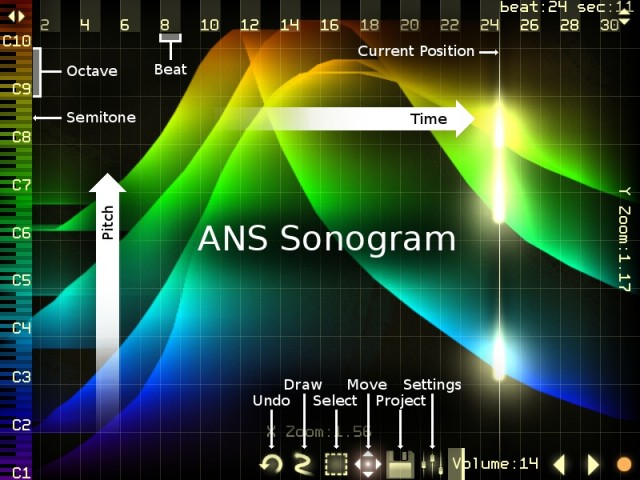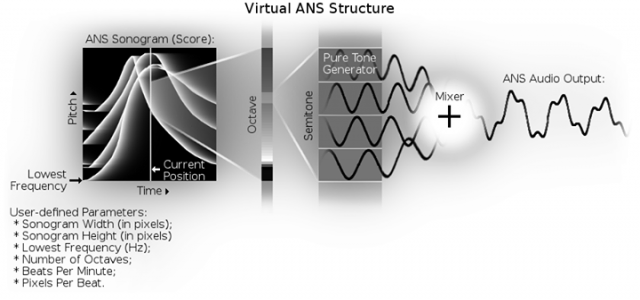
With curves and color, make amazing new sounds on desktop and mobile. Shades of MetaSynth? No, think the half-century-old Russian synth that did it first. Shown: ANS on iPhone.
Few early instruments from the last century can still sound futuristic today. But the photoelectronic ANS synthesizer is an enormous vintage hardware device that can already stand toe to toe with today’s most bleeding-edge software. It’s a natural for an iOS conversion, and an incredible amount of fun to use in software form – but also makes this a good time to revisit just how forward-thinking the original was.
Before electronics grew in wide use in musical instruments, sound designers took a cue from soundtracks for film. That is, before digital, before analog, there was optical. Sound artists, including a number of brilliant Russian engineers, synthesized sounds by imaging them directly on film and running them over photo-optical sensors, as used in sound film projectors of the time. Evgeny Murzin began the ANS project in 1938 with the idea of turning these into a complete musical instrument, capable of realizing sounds with microtonal accuracy – without the use of musicians. The finished instrument finally came into being in 1958.
You might not know your Russian experimental music so well, but you’re more likely to recognize the eerie, singing tones of the ANS from Edward Artemyev’s scores for Tarkovsky’s films, like the 1972 Solaris. And unlike many other such instruments of the time, the original is in working condition in Moscow.
Watching it in action is almost impossibly magical, like a mid-century science fiction fantasy:
More on its history in a moment, but what’s unique about mining the ANS as a model for a software synth is, you can’t really be sure what result you’ll get. Unlike the endless virtual analog models, the timbres and melodic gestures of the ANS are unpredictable. It will seem most familiar to those who used the pioneering U&I graphical tool MetaSynth – but it’s MetaSynth that’s indebted to the ANS, not the other way around.
I’ve been playing around with ANS on my iPhone and iPad, and it’s just remarkable. It’s most adept at sweeping, swooping cries, but you can couple it with a keyboard, and various tools for adding blurs and effects allow you a wide range of possibilities.
Prolific, ingenious developer Alexander Zolotov has produced the iOS version with his usual geeky charm. You can get results right away just by dragging your finger and exploring, but beneath crude-looking, retro-styled menus and icons lurk countless powerful options. And digging through them, while an adventure, is a kind of entertainment in itself. Alexander is the creator of SunVox, the underrated, powerful, omni-platform tracker, plus the visual music-oriented Pixi series of apps and has been making music and developing mobile apps since the days of Palm devices. His personality shows here, as always.
Here’s how it works:
iPhone isn’t your only option. You can run on Android, on iPad, on Windows, on OS X, and Linux – as usual.
And it does – a whole, whole lot.
unique Virtual Analog sound engine;
unlimited number of pure tone generators;
powerful sonogram editor – you can draw the spectrum and play it at the same time;
any sound (from a WAV file or a Microphone/Line-in) can be converted to image (sonogram) and vice versa;
MIDI Input (only for Windows, Linux, OSX and iOS);
supported file formats: WAV (only uncompressed PCM), PNG, JPEG, GIF, VNS (Virtual ANS 1.x);
supported sound systems: ASIO, DirectSound, MME, ALSA, OSS, JACK (iOS and Linux), Audiobus;
iOS: iTunes File Sharing;
iOS: Wi-Fi Export/Import;
It does a lot, and yet: “more functions in the next Virtual ANS updates…”
See videos below.
Learn More About the Original ANS

The ANS today, preserved in Moscow. Photo (CC-BY) Charles Hutchens.
What’s especially beautiful about the ANS is that it was inspired by Scriabin. The Russian composer’s vivid synesthesia caused him to imagine each note as a clear color. And the “ANS” in the ANS is the composer’s initials — Alexander Nikolayevich Scriabin. (Nicely enough, Moscow’s modern art museum right now has an original Scriabin manuscript, in which his clavier à lumières has, notated, all its colored lights for his Prometheus: The Poem of Fire.)
The ANS, then, is an embodiment of the open-ended graphical synthesizer, and of visual music, all at once.
Wikipedia has a solid introduction to the instrument:
https://en.wikipedia.org/wiki/ANS_synthesizer
And there’s a nice overview, in English, on the Russian site electroshock.ru:
Electroshock Records: ANS SYNTHESIZER
Writing for Boing Boing, Klint Finley last year examined some of the deeper significance of the instrument, aesthetically, historically, and politically. Klint fairly connects this to the futurist avant garde in Russia decades earlier:
Soviet synthesizer bridged occultism and electronic music
(By the way, though, I might generally add that I tend only to hear non-Russians refer to “Soviet” instruments. The space program, yes, people refer to as Soviet, but given a more imperfect relationship of arts to the Soviet government, to vastly understate the situation, people tend to just call “Russian” – or whatever the modern-day origin country would be, even if it was part of the USSR at the time. And as Finley says in the article, the ANS project had to survive a hostile government. I would also take issue with the idea that Russian engineers failed to innovate after the ANS – ideas have continued to be shared, and the “prototypes” aren’t only “Western”/”Japanese.” Also – SunVox!)
My favorite article is on the English/Russian site of Theremin.ru. Stanislav Kreichi has written an extensive article, in English, explaining how the ANS works from the compositional standpoint:
The ANS Synthesizer:
Composing on a Photoelectronic Instrument
BBC did a radio program exploring the synth:
And here, for all my new Russian friends, a Russian-language presentation of it. (For all the rest of us, there’s sound part of the way through.)
ANS App In Action
Alexander has made … a lot of videos.
Buying advice: if you have some sort of computer running some sort of operating system made since 2000, go get it:
And yes, do go Like this on Facebook. (Can we, like, Megalike?)
https://www.facebook.com/VirtualAns
On the Facebook page, you’ll find a little community springing up, full of resources and artistic creations. People are already creating beautiful ambient works like this project by Carbonates On Mars, which feels like a gentle orbit round the sun:
Musical Android has done a series of tutorial/feature articles on using the synth:
Virtual ANS – Tips, Conclusions and more part one
Virtual ANS, Sunrizer, AUFX:space and Cubasis by Marcus Padrini
Virtual ANS – Part 4 Recordings and ideas how to use them


